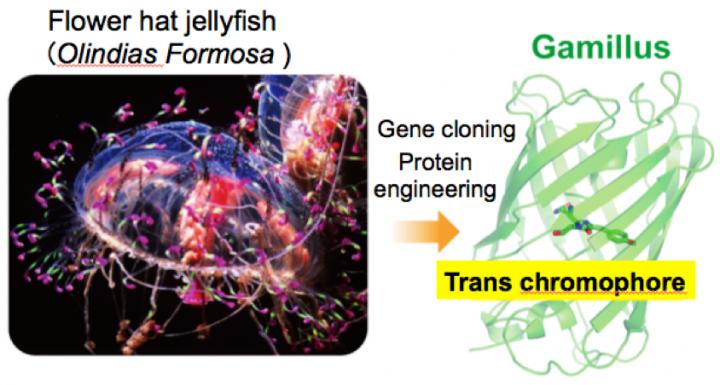Bright and stable: New acid-tolerant green fluorescent protein for bioimaging

A schematic of development of Gamillus. Gene of the fluorescent protein was cloned from tentacles of flower hat jellyfish, and was engineered to improve the monomeric property and the brightness. (The flower hat jellyfish was provided by Mr. Kamoizumi in Kamo Aquarium, Yamagata, Japan.) Credit: Kamo Aquarium and Osaka University
Visualizing cellular components and processes at the molecular level is important for understanding the basis of any biological activity. Fluorescent proteins (FPs) are one of the most useful tools for investigating intracellular molecular dynamics.
However, FPs have usage limitations for imaging in low pH environments, such as in acidic organelles, including endosomes, lysosomes, and plant vacuoles. In environments of pH less than 6, most FPs lose their brightness and stability due to their neutral pKa. pKa is the measure of acid strength; the smaller the pKa is, the more acidic the substance is.
“Although there are reports of several acid-tolerant green FPs (GFPs), most have serious drawbacks. Furthermore, there is a lack of acid-tolerant GFPs that are practically applicable to bioimaging,” says Hajime Shinoda, lead author of an Osaka University study that aimed to design acid-tolerant monomeric GFP that is practically applicable to live-cell imaging in acidic organelles. “In the current study, we developed an acid-tolerant GFP. We called it Gamillus.”
Gamillus is a GFP cloned from Olindias formosa (flower hat jellyfish) and exhibits superior acid tolerance (pKa=3.4) and nearly twice as much brightness compared with the reported GFPs. The fluorescence spectrum is constant between pH4.5 and 9.0, which falls between the intracellular range in most cell types.
X-ray crystallography (a technique used for determining the atomic and molecular structure of a crystal, in this case, a Gamillus crystal) and point mutagenesis suggest the acid tolerance of Gamillus is attributed to stabilization of deprotonation in its chemical structure. The findings were published in Cell Chemical Biology.
“The applicability of Gamillus as a molecular tag was shown by the correct localization pattern of Gamillus fusions in a variety of cellular structures, including ones that are difficult to target,” corresponding author Takeharu Nagai says. “We believe Gamillus can be a powerful molecular tool for investigating unknown biological phenomena involving acidic organelles, such as autophagy.”
Media Contact
All latest news from the category: Life Sciences and Chemistry
Articles and reports from the Life Sciences and chemistry area deal with applied and basic research into modern biology, chemistry and human medicine.
Valuable information can be found on a range of life sciences fields including bacteriology, biochemistry, bionics, bioinformatics, biophysics, biotechnology, genetics, geobotany, human biology, marine biology, microbiology, molecular biology, cellular biology, zoology, bioinorganic chemistry, microchemistry and environmental chemistry.
Newest articles

NASA: Mystery of life’s handedness deepens
The mystery of why life uses molecules with specific orientations has deepened with a NASA-funded discovery that RNA — a key molecule thought to have potentially held the instructions for…

What are the effects of historic lithium mining on water quality?
Study reveals low levels of common contaminants but high levels of other elements in waters associated with an abandoned lithium mine. Lithium ore and mining waste from a historic lithium…

Quantum-inspired design boosts efficiency of heat-to-electricity conversion
Rice engineers take unconventional route to improving thermophotovoltaic systems. Researchers at Rice University have found a new way to improve a key element of thermophotovoltaic (TPV) systems, which convert heat…



